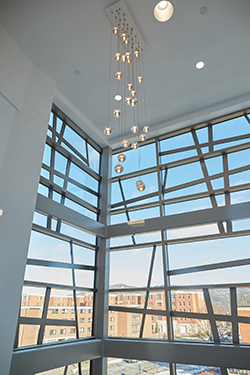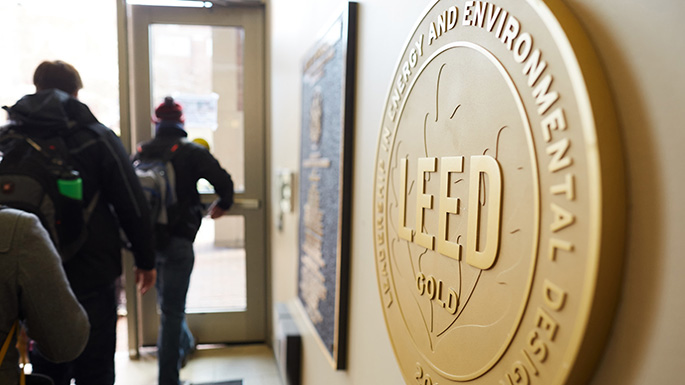Posted 8:41 a.m. Friday, March 31, 2017

The Student Union earns top energy mark.
The Student Union earns top energy mark
The latest building to open at UW-La Crosse is also the latest to receive top marks in its energy and environmental design. The $55 million, student-funded Student Union that opened in January has received LEED Gold Certification. LEED, or Leadership in Energy and Environmental Design, is a national green building certification system. It provides third-party verification that a building was designed and built using strategies aimed at increasing performance, reducing waste and improving quality of life. Sustainable strategies are incorporated in energy use, lighting, water and material use and more. As an added bonus, the buildings save money. The four levels of LEED Certification include: Certified, Silver, Gold and Platinum. Doug Pearson, executive director of UWL Facilities Planning and Management, says the designation is globally recognized for excellence in green building. “LEED’s global sustainability agenda is designed to achieve high performance in key areas of human and environmental health, acting on the triple bottom line — putting people, planet and profit first,” he explains. “The LEED Gold Certification provides documentation that we followed defined building performance strategies that will result in 25 percent less energy, 19 percent lower operating costs, 27 percent higher occupant satisfaction, and 36 percent less CO2 emissions.” [caption id="attachment_48361" align="alignright" width="250"] LED lighting is one of the energy-efficient aspects of the new UWL Student Union that opened in January. The light throughout the entire building is just one of the green design and construction features the led to the building’s LEED Gold Certification.[/caption]
Pearson says LEED certification of the Student Union was based on a number of green design and construction features. Among them:
LED lighting is one of the energy-efficient aspects of the new UWL Student Union that opened in January. The light throughout the entire building is just one of the green design and construction features the led to the building’s LEED Gold Certification.[/caption]
Pearson says LEED certification of the Student Union was based on a number of green design and construction features. Among them:
- LED lighting throughout the building
- building automation system for HVAC controls
- low volatile organic compound (VOC) glues and adhesives
- locally sourced building materials
- additional bike racks to promote alternative modes of travel
- additional daylighting
- storm water management systems
- high-efficiency, centralized cooling system for refrigerators and freezers
- access to mass transit
- low-flow toilets and sink faucets
- reduced light pollution
- high-efficiency motors with variable speed drives.
 Centennial Hall is one of several buildings at UWL built to green building certification standards, Leadership in Energy & Environmental Design (LEED). UWL’s newest building, The Student Union, had just received Gold LEED standing — joining Centennial Hall and Eagle Hall with the prestigious ranks. UWL’s commitment to green building design and energy efficient updates across campus have resulted in lower energy use and budget savings.[/caption]
The New Science Labs Building was designed to LEED Silver standards. The State of Wisconsin Division of Facilities Development follows LEED guidelines for sustainable construction, but the actual verification and certification will not be done by the USGBC.
About LEED
The U.S. Green Building Council’s LEED green building certification system is the foremost program for the design, construction and operation of green buildings. There are four levels of LEED Certification – Certified, Silver, Gold and Platinum. LEED-certified buildings are resource efficient. They use less water and energy and reduce greenhouse gas emissions. As an added bonus, they save money. Over 100,000 projects are currently participating in the LEED rating systems, comprising over 8 billion square feet of construction space in all 50 states and 114 countries. For more information, visit www.usgbc.org.
Centennial Hall is one of several buildings at UWL built to green building certification standards, Leadership in Energy & Environmental Design (LEED). UWL’s newest building, The Student Union, had just received Gold LEED standing — joining Centennial Hall and Eagle Hall with the prestigious ranks. UWL’s commitment to green building design and energy efficient updates across campus have resulted in lower energy use and budget savings.[/caption]
The New Science Labs Building was designed to LEED Silver standards. The State of Wisconsin Division of Facilities Development follows LEED guidelines for sustainable construction, but the actual verification and certification will not be done by the USGBC.
About LEED
The U.S. Green Building Council’s LEED green building certification system is the foremost program for the design, construction and operation of green buildings. There are four levels of LEED Certification – Certified, Silver, Gold and Platinum. LEED-certified buildings are resource efficient. They use less water and energy and reduce greenhouse gas emissions. As an added bonus, they save money. Over 100,000 projects are currently participating in the LEED rating systems, comprising over 8 billion square feet of construction space in all 50 states and 114 countries. For more information, visit www.usgbc.org.